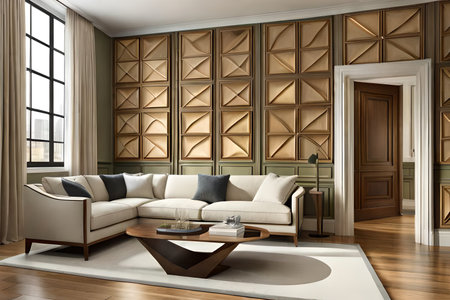1. Understanding the Impact of Light on Art
Lighting plays a crucial role in how we perceive paintings and sculptures. The type of light source used can significantly impact the way colors appear, how textures are revealed, and the depth that an artwork conveys. Whether youre displaying art in a gallery, museum, or home, understanding these effects helps in choosing the right lighting setup.
How Light Affects Color Accuracy
Different light sources have varying color temperatures and CRI (Color Rendering Index), which influence how accurately colors are perceived. Natural daylight is often preferred for its balanced spectrum, while artificial lights like LEDs and halogen bulbs can shift color tones.
| Light Source | Color Temperature | Effect on Art |
|---|---|---|
| Natural Daylight | Around 5000K – 6500K | Provides true color representation but changes throughout the day |
| LED | Varies (2700K – 6500K) | Energy-efficient, available in different tones; high CRI LEDs offer good color accuracy |
| Halogen | Around 3000K | Slightly warm tone, enhances vibrancy but may generate heat |
| Tungsten Incandescent | Around 2700K | Adds warmth to colors but can distort cooler tones |
The Role of Light in Highlighting Texture
Sculptures and textured paintings rely on lighting angles to emphasize depth and detail. Side lighting or raking light (light placed at a sharp angle) enhances shadows and highlights, making textures more pronounced. Soft overhead lighting, on the other hand, minimizes shadows for a smoother appearance.
The Impact of Light Intensity on Depth Perception
The brightness and contrast created by different lighting setups influence how three-dimensional an artwork appears. Too much direct light can flatten details by washing out shadows, while controlled directional lighting helps maintain depth and form.
Choosing the Right Balance
A well-balanced lighting setup considers the combination of color temperature, intensity, and direction to enhance an artwork’s visual impact without causing glare or distortion. Using dimmable lights or adjustable track lighting offers flexibility to adapt to different artworks and settings.
2. The Role of Color Temperature and CRI
When it comes to lighting artwork, two critical factors influence how colors appear: color temperature and the Color Rendering Index (CRI). Choosing the right combination ensures that paintings and sculptures are displayed as intended by the artist while preserving their visual integrity over time.
Understanding Color Temperature
Color temperature, measured in Kelvin (K), determines whether light appears warm, neutral, or cool. Different temperatures can dramatically affect how artwork is perceived.
| Color Temperature (Kelvin) | Appearance | Best Use for Artwork |
|---|---|---|
| 2700K – 3000K | Warm, yellowish-white | Suits traditional paintings and classic artworks; creates a cozy atmosphere |
| 3500K – 4000K | Neutral white | Balances warmth and clarity; ideal for most types of art |
| 5000K – 6500K | Cool, bluish-white | Mimics daylight; good for contemporary art and high-detail pieces |
The Importance of CRI in Artwork Lighting
The Color Rendering Index (CRI) measures how accurately a light source reveals colors compared to natural sunlight. It is rated on a scale from 0 to 100, with higher values indicating better color accuracy.
Why CRI Matters for Art Displays
- Preserving True Colors: A high CRI (90+) ensures that colors appear as they were originally painted or sculpted.
- Enhancing Visual Appeal: Low-CRI lighting can distort hues, making reds look dull or blues appear washed out.
- Avoiding Unwanted Tinting: Poor-quality lighting can introduce unwanted color shifts that alter the perception of an artwork.
Selecting the Right Combination
The best lighting setup combines an appropriate color temperature with a high CRI rating. For most galleries and home displays, aiming for a CRI of at least 90 with a color temperature between 3500K and 4500K provides a balance of warmth and accuracy.
By carefully selecting lighting based on these principles, you can ensure that paintings and sculptures retain their original beauty while being appreciated in the best possible way.

3. Best Lighting Techniques for Paintings
Proper lighting enhances the beauty of a painting while preserving its integrity. The right balance of angle, intensity, and glare control ensures the artwork is well-lit without causing damage over time. Below are key strategies to achieve optimal lighting for paintings.
Choosing the Right Angle
The angle of light plays a crucial role in highlighting textures and details without creating unwanted reflections or shadows.
| Lighting Angle | Effect on Painting |
|---|---|
| 30° | Ideal for most paintings; reduces glare and enhances texture. |
| Less than 30° | May create long shadows and uneven illumination. |
| More than 30° | Can cause excessive reflection, especially on glossy surfaces. |
Controlling Light Intensity
The brightness of the light should be carefully managed to prevent fading or discoloration of the artwork. LED lights with dimmable options work best because they provide flexibility while minimizing heat emission.
Recommended Light Levels
- For oil and acrylic paintings: 150–200 lux
- For watercolor and delicate works: 50–100 lux
- Avoid direct sunlight exposure to prevent UV damage.
Minimizing Glare and Reflections
Glare can obscure details and make viewing difficult. To reduce reflections:
- Use a matte finish glass if framing is required.
- Avoid placing lights directly in front of the painting.
- Opt for adjustable track lighting or wall-mounted fixtures to fine-tune angles.
Best Light Sources for Paintings
The type of light used significantly affects how colors appear. Below are the recommended options:
| Light Type | Advantages | Disadvantages |
|---|---|---|
| LED (3000K–3500K) | Energy-efficient, low heat, adjustable color temperature. | Higher initial cost. |
| Halogen | Crisp white light enhances details. | Produces heat, may require UV filters. |
| Fluorescent | Soft, even illumination. | Poor color accuracy, potential UV damage. |
Final Considerations for Proper Painting Lighting
A well-lit painting should look natural, with colors appearing true to their original form. By carefully adjusting angle, intensity, and glare reduction techniques, you can create an ideal display that highlights the artwork while ensuring its longevity.
4. Optimal Lighting Approaches for Sculptures
Proper lighting is essential for showcasing the depth, texture, and form of sculptures. Unlike paintings, which are typically viewed from a single angle, sculptures require lighting that enhances their three-dimensional qualities from multiple perspectives. By using directional lighting, controlling shadows, and incorporating multiple light sources, you can bring out the intricate details and true essence of a sculpture.
Directional Lighting: Highlighting Form and Texture
Directional lighting plays a crucial role in emphasizing the contours and surface details of a sculpture. The angle and intensity of the light determine how shadows fall, affecting the overall perception of depth. Here are some common lighting angles and their effects:
| Lighting Angle | Effect on Sculpture |
|---|---|
| Frontal Lighting | Minimizes shadows but may flatten the appearance of the sculpture. |
| Sidelighting | Enhances texture and depth by casting strong shadows. |
| Backlighting | Creates dramatic silhouettes but may obscure details. |
| Top-down Lighting | Mimics natural sunlight, adding realism to the sculpture. |
Shadow Control: Balancing Contrast and Depth
The interplay between light and shadow is key to defining a sculpture’s shape. Too much shadow can obscure details, while too little can make the piece appear flat. To achieve balance:
- Avoid harsh shadows: Use diffusers or softer light sources to reduce overly dark areas.
- Create intentional contrast: Position lights strategically to emphasize depth without losing critical details.
- Add fill lighting: Secondary light sources help soften deep shadows while maintaining a sense of dimension.
The Power of Multiple Light Sources
A single light source may not be sufficient to fully capture the complexity of a sculpture. Using multiple lights allows for better control over highlights and shadows. A well-balanced setup often includes:
- Main (Key) Light: The primary source that defines the form and dominant shadow patterns.
- Fill Light: A secondary light that softens harsh shadows and adds more visibility to darker areas.
- Accent or Backlight: Used to create separation from the background or add dramatic effect.
Selecting the Right Bulb Type and Color Temperature
The type of bulb used also affects how a sculpture is perceived. Warm lighting (2700K-3000K) enhances earthy tones, while cooler lighting (4000K-5000K) highlights contemporary materials like metal or glass. LED lights are commonly preferred due to their energy efficiency and minimal heat output, reducing potential damage to delicate materials.
A thoughtful combination of these techniques ensures that sculptures are displayed in their best possible light, bringing out their full artistic impact.
5. Avoiding UV and Heat Damage
When lighting artwork, its crucial to consider the potential damage caused by ultraviolet (UV) radiation and excessive heat. Both factors can lead to fading, discoloration, and material degradation over time. Understanding these risks and choosing the right lighting solutions can help preserve paintings and sculptures for years to come.
The Dangers of UV Radiation
UV light is a major threat to artwork, especially for materials like paper, canvas, textiles, and certain paints. Prolonged exposure can cause:
- Fading of pigments and dyes
- Brittleness in paper and textiles
- Yellowing or deterioration of varnishes
Traditional incandescent and fluorescent bulbs emit varying levels of UV radiation, which can accelerate this damage. To protect valuable pieces, its best to opt for lighting that minimizes or eliminates UV output.
Heat Exposure and Its Effects
Excessive heat from certain light sources can also be harmful to artwork. High temperatures can lead to:
- Cracking or warping of paint layers
- Deterioration of organic materials like wood and canvas
- Softening or melting of certain sculpture mediums
Halogen bulbs, in particular, generate significant heat and should be used with caution or avoided altogether.
Safe Lighting Options
The best way to prevent UV and heat-related damage is to choose lighting that is both safe and effective. Below is a comparison of common lighting options:
| Lighting Type | UV Emission | Heat Output | Recommended for Artwork? |
|---|---|---|---|
| Incandescent Bulbs | Moderate | High | No |
| Fluorescent Bulbs | High (without filters) | Moderate | No |
| Halogen Bulbs | Low (but high heat) | Very High | No |
| LED Lights | Minimal to None | Low | Yes |
Why LEDs Are the Best Choice
LED lights are widely considered the best option for illuminating artwork because they produce little to no UV radiation and generate minimal heat. Additionally, they are energy-efficient and available in various color temperatures, making it easy to achieve the desired lighting effect without compromising the integrity of the artwork.
Tips for Using LEDs Safely:
- Select LEDs with a CRI (Color Rendering Index) of 90 or higher for accurate color representation.
- Aim for a color temperature between 2700K and 3000K for warm, natural lighting.
- Avoid placing lights too close to the artwork to prevent any potential heat buildup.
- Use dimmable LED fixtures to control brightness levels as needed.
Final Thoughts on Protecting Artwork with Proper Lighting Choices
Selecting the right lighting plays a key role in preserving paintings and sculptures. By avoiding UV-emitting sources and minimizing heat exposure with LED options, you can ensure your artwork remains vibrant and undamaged for generations.
